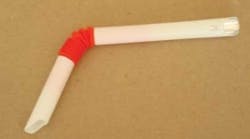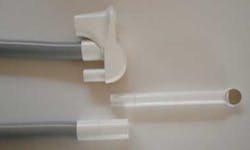Hygienist develops HVE adaptations and becomes an entrepreneur in the process
by Stephanie R. Christman, RDH, BS
"Inventions can come from all fields of interest," states Stephanie R. Christman, who maintains that the dental hygienist is in a unique position to develop ideas for inventions, due to being in an environment that is constantly growing. (Access, Sept-Oct 1990)
Little did I know as a student in the dental hygiene program at Eastern Washington University that, like theI found it awkward and limiting to use the standard high volume evacuation (HVE) equipment while performing ultrasonic and polishing procedures. In dental hygiene school I learned that the HVE made these procedures more comfortable for patients, since it evacuated saliva, water, calculus debris, antimicrobials, and polishing pastes from the patient's mouth more efficiently. Just as important, the HVE system is safer for everyone in the operatory because it helps control potentially harmful airborne aerosols and splatter from patients and dental unit water lines. A low volume saliva ejector is not adequate enough to control aerosol and splatter.1 In recognition of the potential risk for disease transmission, the Centers for Disease Control and Prevention (CDC) have indicated that dental aerosols and splatter should be controlled to the greatest extent possible.2 I knew there had to be a solution that included the HVE suction capabilities, while allowing for ease of use and comfort for both patient and hygienist. This was the foundation for the development of the HyGenie evacuation system.
These statistics include only compensation figures and not medical care expenses.4 Studies show 72% to 86% of all dental hygienists experience work-related pain as a result of muscle imbalances and overworked muscles. These unique musculoskeletal challenges occur when delivering dental care and, despite ergonomic advances, these problems have not been resolved.5 The rising incidence and costs of treating these conditions is negatively impacting productivity in the form of higher workers' compensation costs and lost time when hygienists seek treatment for these conditions.
When using the current HVE equipment, we are unable to directly view many areas of the oral cavity since we use the HVE with the same hand that normally holds our dental mirror, while our other hand operates another instrument. A dental assistant is not available to assist in evacuating in most clinics; therefore, many hygienists elect not to use the HVE equipment. Instead, many of us opt for the low volume saliva ejector, which is placed on the inside of the patient's cheek so that one hand can operate an instrument and the other hand can hold the dental mirror for a better view.
Using the saliva ejector alone can increase patient discomfort due to the ineffective removal of water, antimicrobials, and debris. This often results in patients experiencing coughing, choking, and nasal inhalation. Oral tissues can become dry and irritated, and teeth can become sensitive to the suction when the saliva ejector is tucked inside the cheek. In addition, it is very important to use an HVE for suctioning acid etchants during sealant placement.
I clearly saw the problems with the hygienists' two main suction options. "If only I could see what I was doing in a few of these hard to view areas of the mouth while still using an HVE," I thought. I came up with an idea to enable better lines of sight while evacuating, and to make the high volume evacuator more comfortable and easier to handle. I went to work on the evacuator tip and tried to incorporate a small mirror into the inside tip of one open end. I cut the plastic HVE tip in half and inserted each half into a flexible straw (Figure A).
The flexible creases allowed the HVE to be bent at a 90-degree angle, which allowed me to hold the HVE in a penlike grasp for the full duration of the cleaning. With the mirror surface inserted into the tip, I could view all surfaces of each tooth in the patient's mouth during the ultrasonic scaling and polishing procedures (Figure B). Since the plastic is rigid and shortened, a hygienist can use this new suction to retract the patient's lips, cheeks, and tongue. I wanted this new type of HVE to be for hygienists, so I called it the HyGenie. I had a name and a rough prototype, and an acquaintance helped me make the prototype look and act more like what I had envisioned (Figure C). But then life got busy and the project was put on the back burner.
When I finally restarted, I was working full time at Willamette Dental6, the largest privately owned group practice in the country with 60 clinics in four states. The standard of care and Willamette Dental's evidence-based treatment protocol was for hygienists to reduce attached and unattached plaque biofilm and calculus deposits above and below the gum line with the ultrasonic scaler. These guidelines included everyone at least 13 years of age. Every day I thought about how much easier the job would be with my unfinished HyGenie HVE tip.
Dr. Robert Finkelstein, regional managing dentist at Willamette Dental, encouraged me to keep working to make my vision a reality. I also shared my idea with Dr. John Palmer (a general dentist at Willamette Dental), and he helped me get the project rolling again. On the Web, we located retired chief marine engineer Terry Fitzthum, who helped arrange the manufacturing of the HyGenie HVE tip (Figure D). With Dr. Palmer's advice, Fitzthum developed a lightweight hose with a swivel that could be attached to the existing HVE valve on one end, and the new HyGenie HVE tip on the other end (Figure E). The new hose is called the HyDra Swivel Hose.
Samples of the new HVE tip and swivel hose, along with a questionnaire, were sent to several hygienists and dentists. We received comments such as, "Procedure was more comfortable for the patient because the chlorhexidine didn't pool up in the back of the mouth and there was no spray under the nose." "The mirror stays clear with good visibility, suction is good – better than I thought. I didn't notice that there was much escaping aerosol." "Less water pooling on the left side and the tongue was retracted out of the way of the ultrasonic." "There is no effort required of the muscles of the wrist and hand due to the ergonomic design of the swivel connection at the end of the HyDra Hose. This allows the HyGenie tip to rotate effortlessly and makes it easy to work alone." After receiving these encouraging comments, we had the HyGenie name trademarked and obtained the services of a patent attorney. With his counsel we patented the tip and hose together and named it the HyGenie HVE with HyDra Swivel Hose System.
During this time we became clients of SIRTI,7 a Washington State economic development agency in Spokane. SIRTI is an incubator that assists technology-based start-up companies, and teaches entrepreneurs the skills necessary to get their products to market. SIRTI gave us expert advice and guidance and put us in touch with accounting, law, and business students who helped us put together a business and marketing plan, a value proposition, a business proposal, and a corporation that my husband and I call HyGenie, Inc. They also put us in touch with a graphic consultant for the design of our product labels, and a local insurance company for product liability insurance.
One of the most important steps we took was funding to get our product to the dental market. We briefly explored locating outside "angel" investors, but decided instead to self-fund our product and finance it step by step. We realized that not all businesses need outside investors to be successful. Our four major expenses were the patent and lawyer fees, having a mold designed and built, having a molder run the mold to produce the product, and product liability insurance. We also looked into outsourcing our product to China, but decided there would not be much difference due to shipping costs. By having it manufactured locally we would have more control of the product and quality, and quicker turnaround. We are also proud to print "Made in the USA" on our label. This all took several thousand dollars, persistence, patience, and a very strong belief in the viability of our product, and we did it all without having to bring in outside funding.
The HyGenie HVE tip is manufactured in Post Falls, Idaho, and Fitzthum is manufacturing the HyDra Swivel Hose in Spokane. Both are available through the Practicon Dental Web site.8 We also worked with a Web designer9 who put together our Web site10, which describes the features and benefits of the HyGenie HVE and the HyDra Swivel Hose, includes a video that shows how they're used together, and an ordering page for direct sales. We would like to thank Willamette Dental for the use of their dental clinic to test the product and make the video.
Learning 20 years ago as a student at EWU that other hygienists could improve the dental experience through their innovations gave me the confidence to pursue my idea. The knowledge and experience I have acquired in the dental field the past 20 years, especially at Willamette Dental, fostered my idea of the HyGenie HVE and convinced me it will be a welcome innovation for dental providers. Our system is more comfortable for the patient, allows for better sight lines and ergonomics for the hygienist, and promotes safer air quality in the dental environment.
Author's note: I would like to express my gratitude to Kristen Simmons, RDH, VP of Strategy and Development at Willamette Dental, for encouraging me to write my story.
Stephanie R. Christman, RDH, BS, received her CDA over 30 years ago in Colorado, her BS in dental hygiene in 1990, and is a longtime member of the ADHA. She has worked at Willamette Dental for 14 years as a lead dental hygienist. She continues to work full time and spends two days a month as a restorative hygienist. Volunteering is important to her, as she has provided dental services for several organizations including the Ronald McDonald Dental Mobile, and she is eager to provide more volunteer hygiene services. Stephanie has also spent time as a "seagienist" on a cruise ship providing hygiene services for the crew. Stephanie enjoys family, cycling, and her new hobby of beekeeping.
References
- Harrel SK, Molinari J. Aerosols and splatter in dentistry: a brief review of the literature and infection control implications. J Am Dent Assoc.2004;135:429-437.
- Kohn WG, Collins AS, Cleveland JL, et al. Guidelines for infection control in dental health-care settings-2003. MMWR Recomm Rep. 2003:52(RR-17):1-61.
- Upper Extremity Musculoskeletal Disorders in Dental Hygiene: Diagnosis and Options for Management, Contemporary Oral Hygiene, June 2004.
- Washington State Department of Labor and Industries
- Managing Muscles: Neck and Shoulder Pain Among Dental Hygienists, Contemporary Oral Hygiene, Dec 2004.
- WillametteDental.com
- SIRTI.org
- Practicon Web site. practicon.com/HyGenie-HVE-with-HyDra-Swivel-Hose-System/p/71-14410/
- NickBrandt.net web design
- HyGenieHVE.com
Past RDH Issues











